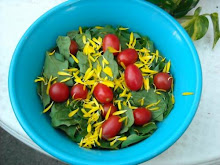 Via Facebook messenger, late in the evening on May 4, 2010.
Via Facebook messenger, late in the evening on May 4, 2010.[Side note: I went to high school with the person asking the question--hence all the geography that means nothing to the rest of you. Also, this didn't fit the standard Q. and A. format, so I switched to Q. and Garden Ninja]
Q. Okay since you are a gardening whiz...what zone is Romney in? Not that I even know what a zone is.
GN. Romney is roughly in zone 6. But . . . !
Q. Oh, here comes the bad news...
GN. A zone is basically a measure of how harsh the weather is, how short the growing season is, etc. Smaller numbers = more arctic, larger numbers = more tropical.
GN. But . . . ! You have to account for microclimates.
Q. WHAT!?!?!??!?! That is just way too brainy... what is a microclimate!? Lol, I'm hopeless.
GN. Sometimes a particular valley will be a little warmer, or it will be colder near a river, or it'll be affected by surrounding buildings, pavement, etc. You're not hopeless! You just have to try things out. Use the zone as a guideline, and experiment.
Q. Ahhhh, like Hampshire High is ALWAYS colder than Romney town.
G.N. Exactly. Elevation is a factor.
Q. Well see here's my thing. There's a rose tree that I LOVE, only rose I like for that matter.
G.N. Cool . . . what kind?
Q. Fire and Ice.
GN. Ooh! One of the two-toned ones! I love those.
Q. Yup, pure white and bright red. Gorgeous. Yeah, it's got to be in zone 6 or warmer.
GN. You should be fine. You might have to baby it a little over winter--trim it back and mulch over it a little. Here's a pretty good link about rose care in winter. http://www.uri.edu/ce/factsheets/sheets/roseswinter.html
"For maximum winter protection, cover the rose bush with a protective cylinder. Use straw, leaves, or similar material to insulate the bush inside the cone. Puncture several one inch holes around the top of the cone for air circulation."
GN. I usually do the thing they talk about with a cone and straw, except I used upturned tomato cages and leaves, lol! It's what I had around.
Q. I will definitely refer to that. Thanks for the info!
GN. If you have any problems with the rose, let me know. Have you gotten it yet, or are you just ordering it now?
Q. Just looking into it. If I order it bare root, I may want to wait. I am still reading up on all that stuff.
GN. Good plan! The next thing I was going to say was to make sure to read up on proper planting technique BEFORE you shove the poor thing into the ground.
Q. I like picking out flowers and weeding, but not all the landscaping stuff my hubby is supposed to know. Unfortunately, he's from Rhode Island and was never in an area to even see a Fire and Ice.
GN. If he's ever planted fruit trees or any large shrub, the principles are the same. Huge hole, good backfill, water faithfully until it settles in. Good placement, too--plenty of sun.
Q. Yeah he's done TONS of that. Cool, so he'll know the basics. Thanks again for the info.
GN. No problem.








